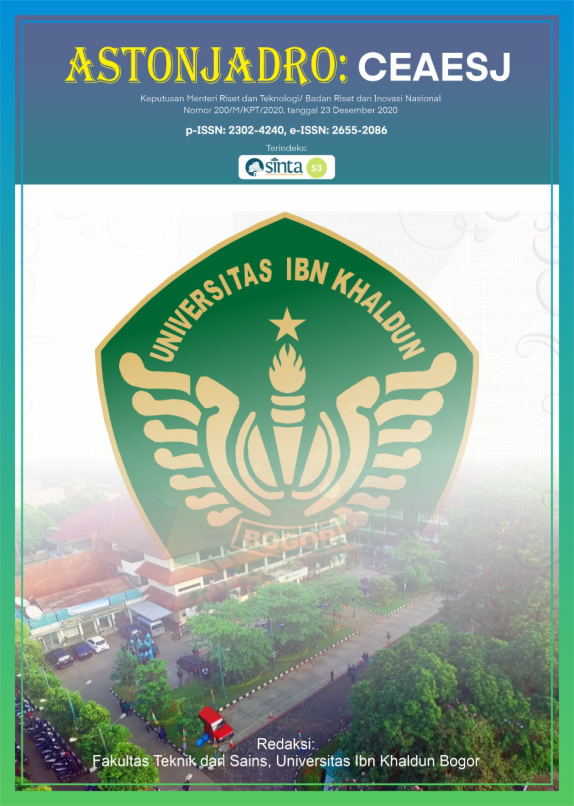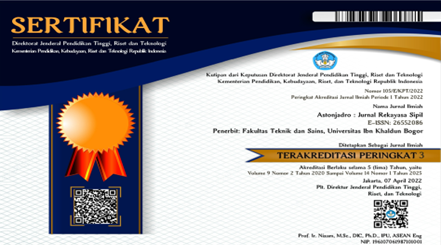EVALUATION OF ARCHITECTURAL COMPONENTS IN BAYUNG GEDE VILLAGE SETTLEMENT, BALI AS A TOURISM OF SPECIAL INTEREST
DOI:
https://doi.org/10.32832/astonjadro.v11i1.5939Keywords:
tourism village, traditional settlements, special interest tours.Abstract
Special interest tourism is one of the efforts to provide alternative tourist attractions and sustainable tourism development in Bali. Visits of both domestic and foreign tourists to Bali in the last 4 years (2015-2019) have increased by an average of 8%. Now the tourism sector in Bali, especially in Bangli Regency, is starting to investigate or explore the possible development of tourist attractions through the development of tourist villages. In this case, the development of special tourism, including the tourist village of Bayung Gede, Bangli is very dependent on the architectural components of traditional settlements and the traditions of the residents in it as a source of attraction and main attraction for tourists. However, the influence of tourism has led to the transformation of traditional settlements. In this case, the transformation has given rise to a paradoxical phenomenon where on the one hand traditional housing attracts tourists, on the other hand the presence of tourists has led to a transformation of the traditional settlements of an area. The purpose of this study is to examine the architectural components of the Bayung Gede Village settlement as a tourism potential based on special interest tourism and then to find out how far the tourism architectural potential is found and how strong the Bayung Gede Village settlement icon is as a special interest DTW. The method used is a qualitative-exploratory and descriptive method. The results show that the traditional settlement of Bayung Gede Village contains elements of special interest tourism such as elements of novelty seeking, quality seeking, enriching, rewarding, adventuring and learning, so that it has the potential as religious tourism (the existence of four types of graves), culture (settlement and residential layout) and citrus plantation sector agro-tourism in improving the economic sector of the community. Investigation and inventory of Bayung Gede traditional housing is an effort to find a village icon that has prestige that can attract tourists to visit and be able to compete with other tourist villages.
References
Adhika, I. M., & Putra, I. D. G. A. D. (2021). Reinvigorating cultural landscapes for planning cultural tourism in Bali. Geojournal of Tourism and Geosites, 33(4), 1462–1469. https://doi.org/10.30892/gtg.334spl03-594
Ayu Natih, dkk. 2019. Arsitektur Tradisional Bali pada Bangunan Puri sebagai Daya Tarik Wisata dalam Mendukung Pengembangan Pariwisata Berkelanjutan di Bali. PUSAKA: Journal of Tourism, Hospitality, Travel and Business Event. Vol. 1. No. 2. Hal. 46-52. (Indonesian).
Aritama, A. A. N., & Putra, I. D. G. A. D. (2021). Tourism Activities in the Traditional Balinese House: The Challenges of Designing a Homestay in Gianyar Bali. Journal of Social and Political Sciences, 4(1). https://doi.org/10.31014/aior.1991.04.01.250
Banglikab. 2014. Peraturan Daerah Bupati Bangli Nomor 16 Tahun 2014. Bangli. (Indonesian).
Basset, Keith & Short, John, 1980. Housing and Residential. Structure, Alternative Approaches. London: Routledge & Kegan Paul Ltd.
Dewa Gede Agung Diasana Putra, I. (2019). The Disproportional Arrangement of the House: The Biodiversity Spaces and the Transformation of the Traditional Balinese House in Tourism Economy. In Tourism - Perspectives and Practices. https://doi.org/10.5772/intechopen.81989
Dwijendra, N. K. A. (2009). Arsitektur dan Kebudayaan Bali Kuno. Udayana University Press dan CV Bali Media Adhikarsa. (Indonesian).
Dwijendra, N. K. 2003. Perumahan dan Permukiman Tradisional Bali. Jurnal Permukiman "NATAH" Vol.1 No.1, 8-24. (Indonesian).
Gede Wijaya A.A. 2008. Pengembangan Desa Wisata Tenganan Pegringsingan di Desa Tenganan Kecamatan Manggis Kabupaten Karangasem. Tesis S2 Kajian Pariwisaa Unud. (Indonesian).
Gelebet, I Nyoman. dkk. 1986. Arsitektur Tradisional Daerah Bali. Denpasar: Departemen Pendidikan dan Kebudayaan Proyek Inventarisasi dan Dokumentasi Kebudayaan Daerah. (Indonesian).
Gelebet, I Nyoman, 1988.Arsitektur Tradisional Daerah Bali. Depddikbud. (Indonesian).
Manik, Yuda. 2007. Pengaruh Demografi, Gaya Hidup, dan Aktivitas Terhadap Transformasi Tipo Morfologi Hunian Tradisional di Desa Bayung Gede, Bali. Tesis Arsitektur ITB. (Indonesian).
Putra, I.D.G.A. 2003. Konsepsi Dan Makna Arsitektur Tradisional Pada Bangunan Kekinian Sebuah Intepretasi Masyarakat Lokal Bali Tengah Pada Transformasi Rumah Tradisional. Vol. 1 No. 1, 1-21 – 1-30. (Indonesian).
Parimin, A. P. (1986). Fundamental study on spatial formation of island village: environmental hierarchy of sacred-profane concept in Bali. 大阪大å¦.
Putra, I.D.G.A. 2015. The Impact of Tourism on the Tranformation of the Traditional Balinese House. Unpublished PhD Thesis, Deakin University, Australia.
Putra, I. D. G. A. D., Lozanovska, M., & Fuller, R. (2019). From spiritualistic toward more pragmatic pattern: Re-ordering Balinese houses and viability of the household traditions in tourism economy. Journal of Architecture and Urbanism, 43(1). https://doi.org/10.3846/jau.2019.3692
Putra, I. D. G. A. D., Wirawibawa, I. B. G., & Satria, M. W. (2020). Spatial orientation and the patterns of the traditional settlement in the eastern Bali: Investigating new tourism atractions. Geojournal of Tourism and Geosites, 29(2). https://doi.org/10.30892/gtg.29218-493
Reuter, T. (2002). The house of our ancestors: precedence and dualism in highland Balinese society. Brill.
Reuter, T. A. (1996). Custodians of the sacred mountains: The ritual domains of highland Bali.
Sangadji, E. M., & Sopiah. (2010). Metodologi Penelitian: Pendekatan Praktis dalam Penelitian. Yogyakarta: ANDI. (Indonesian).
Sedarmayanti, Sastrayuda, G. S., & Afirza, L. (2018). Pembangunan dan Pengembangan Pariwisata. Bandung: Refika Aditama. (Indonesian).
Setyanto, I., & E. P. (2019). Pengaruh Komponen Destinasi Wisata (4A) Terhadap Kepuasan Pengunjung Pantai Gemah Tulungagung. Jurnal Administrasi Bisnis, Volume 72 No 1, 157-167. (Indonesian).
Siwalatri, Ni Ketut Ayu. 2014. Makna Sinkronik Arsitektur Bali Aga di Kabupaten Buleleng Bali. (Indonesian).
Sugianto, A. (2016). Kajian Potensi Desa Wisata Sebagai Peningkatan Ekonomi Masyarakat Desa Karang Patihan Kecamatan Balong Ponorogo. Jurnal Ekuilibrium Vol.11 No.1, 56-65. (Indonesian).
Swanendri, N. (2017). Transformasi Rumah Tinggal dan Pola Spasial Permukiman Masyarakat Bali Aga Desa Pekraman Timbrah, Desa Pertima, Kecamatan Karangasem, Kabupaten Karangasem. Denpasar. (Indonesian).
Syamsul Alam Paturusi. 2017. Permukiman Bali Kuno Desa Bayung Gede sebagai Atraksi Pariwisata di Bali. Seminar Nasional Arsitektur dan Tata Ruang. Hal. 4-57 – 4-66. (Indonesian).
Widhiarini, N. N., Oktaviani, P., & Permanita, N. D. (2019). Arsitektur Tradisiona; Bali Pada bangunan Puri Sebagai Daya Tarik Wisata Minat Khusus Dalam Mendukung Pengembangan Pariwisata Berkelanjutan. PUSAKA: Journal of Tourism, Hospitality, Travel and Business Event Vol.1, No.2, 46-52. (Indonesian).
Windu, Gede Laskara. 2008. Arsitektur Vernakuler Desa Bayung Gede, Bangli. (Indonesian).
Widiastuti, S. A. Paturusi, dkk. (2017). Perubahan Arsitektur Tradisional Hunia Desa Bayung Gede, Bangli. Seminar Nasional Arsitektur dan Tata Ruang. Hal. 3-109 – 3-119. (Indonesian).
Downloads
Published
How to Cite
Issue
Section
License
Copyright (c) 2021 ASTONJADRO: CEAESJ

This work is licensed under a Creative Commons Attribution-ShareAlike 4.0 International License.
Paper submitted to ASTONJADRO is the sole property of the Astonjadro Journal. Unless the author withdraws the paper because he does not want to be published in this journal. The publication rights are in the journal Astonjadro.ASTONJADRO
LICENSE
This work is licensed under a Creative Commons Attribution-ShareAlike 4.0 International License.
Based on a work at http://ejournal.uika-bogor.ac.id/index.php/ASTONJADRO













